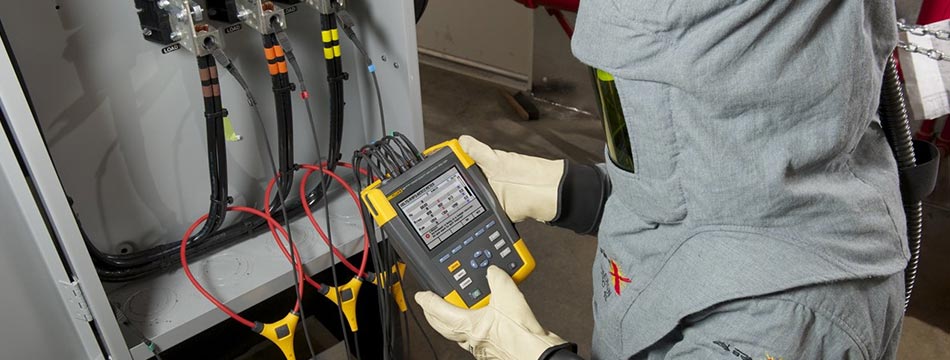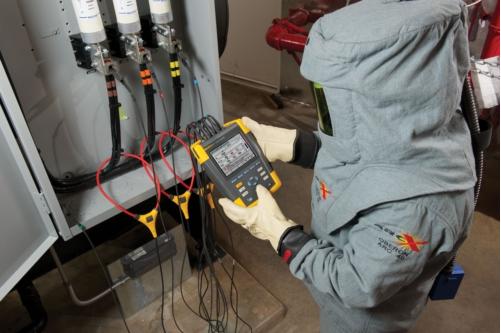
All electrical systems have a defining factor known as power quality. At the peak of its operation, a newly manufactured machine should have a high level of power quality, ensuring that it works correctly at all times.
Power quality is, however, unfortunately affected by time, machinery stress, dust, contaminants and various other factors, degrading over time until the efficiency of the system drops below the nominal value and as a result productivity, profits and production may drop while the machine becomes harder to use and becomes potentially dangerous.
The best way to counteract this, particularly with essential, industrial-grade systems, is to regularly carry out power quality analysis in order to determine the problems with a system before they become significantly more potent. The problem with this is more often than not it requires outsourcing to a specialist power quality analysis firm which means a high potential cost and potential downtime while you wait for the team to arrive and rectify problems with your system.

When using process machinery, which operates constantly and repeats actions, degraded power quality that causes malfunctions, loss of performance or loss of life altogether can mean significantly reduced profits. Without the machinery nothing is produced, ultimately leading to a vast reduction in profitability that could have been prevented due to regular power quality analysis.
Preventive Maintenance – What You’re Missing
As an electrician, it’s traditionally been harder to get into power quality analysis work due to the complex nature of instruments used within the process and the extensive knowledge needed to determine what power quality is and how it can be correctly implemented. In modern society this is beginning to change as power quality analysis tools advance and become easier to use, opening up new and exciting opportunities for electrical contractors to expand their work abilities.
Commonly known as PM, which is short for preventive maintenance, this branch of electrical contracting is growing faster than ever before. The goal of PM is to keep equipment and facilities in satisfactory operating condition by providing for systematic inspection, detection and correction of problems in the early stages – in other words, it’s evaluating the power quality of a system, taking action against problems and ensuring that massive defects don’t have a chance to occur.
This process requires the use of specialist tools, most commonly known as a power quality meter or power quality analyser. Unfortunately many who try preventative maintenance don’t know how to use this equipment and use tools such as common DMMs to find problems. This is highly inefficient and not suitable for use in power quality.

According to Fluke, who investigated the field of power quality, contractors more often than not came back to them saying that they used digital multimeters instead as they simply didn’t have time to learn how power quality tools work. This means that many contractors are putting both themselves and others at risk due to using the incorrect tools for a job.
This doesn’t have to happen – power quality analysers have now advanced to the point where extensive specialist training isn’t as necessary as it once was, opening up the doors to those interested in adding a new string to their bow with preventive maintenance contracts.
Of course some training may still be required to use the equipment effectively and safely, but the barriers for entry into this vast field are much more eroded than they’ve ever been.
Power Quality Analysers – What’s The Difference?
We’ve just mentioned that DMMs aren’t particularly suited to use on complex electrical systems, but why is this the case?
Common digital multimeters are built for use on single phase systems, meaning they’re not suited at all to evaluate complex three phase equipment. If they are used this means that each phase must be tested individually and potential problems may be missed due to changes in system integrity.
In comparison a power quality analyser is built for use in measuring all three phases of a system simultaneously, allowing trends to be spotted and the entire system to be monitored graphically over a time period. Instead of testing parameters individually, a power quality analyser looks at the entire system, speeding up testing and allowing determination of power quality status to be significantly more accurate.
It doesn’t stop there either – here’s why power quality analysers are essential for use in preventive maintenance:
- Waveform display – many analysers present the waveforms of a system as a graphical diagram, allowing the electrician to understand the technicalities of power quality and explain to a customer with graphical prompts what has went wrong. This system also allows older waveforms to be stored and compared against the new to spot new potential problems
- Analysis – trend such measurements as RMS and peak voltage, RMS and peak current, crest factor, watts, VA, VARs, power factor, displacement power factor and frequency in order to spot trends and sudden strange occurrences that appear on a system
- Multi-channel inputs – power quality analysers allow phase comparison to be taken in real time. This is the only way to ensure accuracy when testing as using a DMM means you are limited to single measurements on a phase
Not only does this provide a contractor with the ability to understand the technicalities of a system in an easy-to-understand manner, but it also allows contractors to open new avenues of business by spotting problems within systems that weren’t detected. You can then alert the customer about these problems and potentially open up more business as they’re more likely to hire the professional who spotted it in the first place.
The Fluke 430 Series – The Easy Way into Preventive Maintenance
Easily among the best power quality analysers on the market today are Fluke’s 430 series. Built with Fluke’s traditional reliability and design made to enhance a professional’s working life, these tools are rapidly becoming the go-to choice for those who work in preventive maintenance applications and need to gain a comprehensive map of power quality.
The Fluke 435 in particularly is one of the most popular power quality analysers. Here’s why professionals trust this device for preventive maintenance applications:
- Power inverter efficiency: Simultaneously measure AC output power and DC input power for power electronics systems using optional DC clamp
- PowerWave data capture: Capture fast RMS data, show half-cycle and waveforms to characterize electrical system dynamics (generator start-ups, UPS switching etc.)
- Energy loss calculator: Classic active and reactive power measurements, unbalance and harmonic power, are quantified to pinpoint the fiscal costs of energy losses
- Troubleshoot real-time: Analyze the trends using the cursors and zoom tools
- Highest safety rating in the industry: 600 V CAT IV/1000 V CAT III rated for use at the service entrance
- Measure all three phases and neutral: With included four flexible current probes with enhanced thin flex design to fit into the tightest places
- Automatic Trending: Every measurement is always automatically recorded, without any set-up
- System-Monitor: Ten power quality parameters on one screen according to EN50160 power quality standard
- Logger function: Configure for any test condition with memory for up to 600 parameters at user defined intervals
- View graphs and generate reports: With included analysis software
- Battery life: Seven hours operating time per charge on Li-ion battery pack
- Comprehensive view of system: the 435 evaluates current, voltage, crest factor, frequency, power, power factor, energy, harmonics, phase angle, unbalance and more
Fluke 430 Comparison Chart
Interested in getting into power quality analysis? This comparison chart should help you understand why Fluke's power quality analysers are the best option for your needs:
 |
 |
|
Fluke 434 Series II Energy Analyser |
Fluke 435 Series II Power Quality & Energy Analyser |
|
| Users | Electricians Basic Power Quality Users |
Industrial Electricians Utilities Technicians Advanced Power Quality Users |
| Applications | Power and energy analysis using the Energy Loss Calculator—discover the cost of energy waste due to power quality issues.Basic PQ V/A/Hz, power, dips, swells, harmonics, unbalance , full visibility in to the key issues with little or no setup time—discover the source of power quality problems and fix them quicklyPower Inverter Efficiency: simultaneously measure input and output power of inverters in solar, wind and UPS apps—enables inverter systems to be optimized for best performance. |
PowerWave waveform capture: capture up to 5 minutes of fast RMS and waveform data—view the dynamic interactions between the power system and switching loads, perfect for generator testing.Power Inverter Efficiency: simultaneously measure input and output power of inverters in solar, wind and UPS apps—enables inverter systems to be optimized for best performance.Advanced PQ, flicker, transients, Class A compliance—the best accuracy for reliable power quality surveys, independently verified by industry specialist PSL of California.Power and energy analysis using the Energy Loss Calculator—discover the cost of energy waste due to power quality issues. |
| Key Features | Waste Energy CalculatorPower Inverter EfficiencyClass S IEC 61000-4-30 complianceVoltage, frequency and current testingDips and swells calculationHarmonic calculationPower & Energy measurement toolsEnergy loss calculatorUnbalance and monitor
Inrush current mode Power inverter efficiency 8GB SD Card |
Advanced Power Quality MeasurementsPowerWave Data CapturePower Inverter EfficiencyEnergy Loss CalculatorClass A IEC 61000-4-30 complianceVoltage, frequency and current testingDips and swells calculationHarmonic calculationPower & Energy measurement tools
Energy loss calculator Unbalance and monitor Inrush current mode Event waveform capture Flicker Transients Mains signalling Power wave Power inverter efficiency 8GB SD card |


